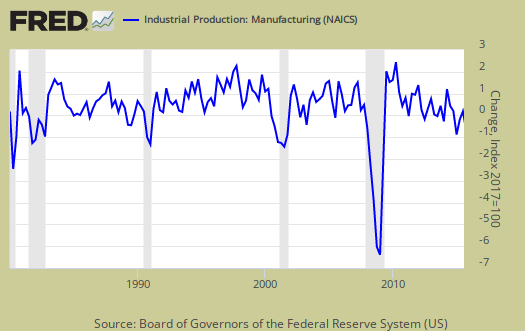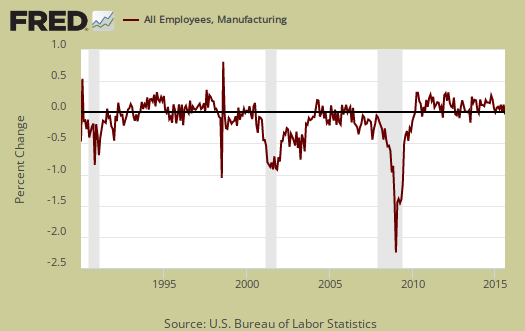The September ISM Manufacturing Survey shows yet more deceleration of the manufacturing sector. While a PMI of 50.2% is still growth, it is barely growth. The composite PMI decreased by -0.9 percentage points and new orders decreased by -1.6 percentage points. Order backlogs truly imploded. Overall the report really shows a weakening manufacturing sector and this is so disconcerting it is probably another signal for the Fed to delay raising interest rates.

The ISM Manufacturing survey is a direct survey of manufacturers. Generally speaking, indexes above 50% indicate growth and below indicate contraction. Every month ISM publishes survey responders' comments, which are part of their survey. Most mention slowdowns and reduced demand with specifics on the collapse in oil prices, China and Bird flu. Manufacturers also complain of a strong dollar hurting their procurement pricing.
New orders really slid yet another -1.6 percentage points to 50.1%. This is precariously on the edge of growth, tipping towards contraction.

The Census reported August durable goods new orders decreased b a large -2.0%, where factory orders, or all of manufacturing data, will be out later this week. Note the Census one month lag from the ISM survey. The ISM claims the Census and their survey are consistent with each other and they are right. Below is a graph of manufacturing new orders percent change from one year ago (blue, scale on right), against ISM's manufacturing new orders index (maroon, scale on left) to the last release data available for the Census manufacturing statistics. Here we do see a consistent pattern between the two and this is what the ISM says is the growth mark:
A New Orders Index above 52.3 percent, over time, is generally consistent with an increase in the Census Bureau's series on manufacturing orders.

Below is the ISM table data, reprinted, for a quick view.
| ISM Manufacturing September 2015 | ||||||
|---|---|---|---|---|---|---|
| Index | August 2015 | September 2015 | % Change | Direction | Rate of Change | Trend Months |
| PMI™ | 51.1 | 50.2 | -0.9 | Growing | Slower | 33 |
| New Orders | 51.7 | 50.1 | -1.6 | Growing | Slower | 34 |
| Production | 53.6 | 51.8 | -1.8 | Growing | Slower | 37 |
| Employment | 51.2 | 50.5 | -0.7 | Growing | Slower | 5 |
| Supplier Deliveries | 50.7 | 50.2 | -0.5 | Slowing | Slower | 2 |
| Inventories | 48.5 | 48.5 | -1.0 | Contracting | Same | 3 |
| Customers' Inventories | 53.0 | 54.5 | +1.5 | Too High | Faster | 2 |
| Prices | 39.0 | 38.0 | -1.0 | Decreasing | Faster | 11 |
| Backlog of Orders | 46.5 | 41.5 | -5.0 | Contracting | Faster | 4 |
| Exports | 46.5 | 46.5 | 0.0 | Contracting | Same | 4 |
| Imports | 51.5 | 50.5 | -1.0 | Growing | Slower | 32 |
| OVERALL ECONOMY | Growing | Slower | 76 | |||
| Manufacturing Sector | Growing | Slower | 33 | |||
Production, which is the current we're makin' stuff now meter, decreased by -1.8 percentage points to 51.8%. This is still growth but barely and yet another bad number for manufacturing. Production usually follows incoming orders in the next month.

ISM's manufacturing production index loosely correlates to the Federal Reserve's industrial production, but not at 50% as the inflection point, instead 51.1% to indicate growth. Below is a quarterly graph of the ISM manufacturing production index (left, maroon), centered around the inflection point, quarterly average, against the Fed's manufacturing industrial production index's quarterly change (scale right, blue). We can see there is a matching pattern to the two different reports on manufacturing production.

The manufacturing ISM employment index also declined by -0.7 percentage points to 50.5%. This doesn't bode well for September manufacturing employment figures that will be released on Friday. The neutral point for hiring vs. firing is 50.6%. Below are the BLS manufacturing non-farm payrolls (jobs) for the past decade on the left (maroon), graphed against the ISM manufacturing employment index on the right (blue). The BLS manufacturing payrolls is the monthly percentage change and the ISM manufacturing employment index is centered around it's inflection point of contraction and employment growth.

The inventories index are contracting for a second month in a row with no change in acceleration. Changes in inventories contributes to GDP . Inventories gives an estimate of how much raw materials manufacturers have on hand and the contraction implies manufacturers expect a slow down to continue. Quoted below is the relationship between BEA and ISM inventories, not the 50% inflection point one would assume.
An Inventories Index greater than 42.9 percent, over time, is generally consistent with expansion in the Bureau of Economic Analysis' (BEA) figures on overall manufacturing inventories in chained 2000 dollars.

Supplier deliveries are how fast manufacturers can get their supplies. A value higher than 50 indicates slower delivery times, a value below 50 means the supply chain is speeding up. The index decreased by --0.5 percentage points to 50.2% which is another bad sign, even though this is still slower deliveries. You may wonder why slow deliveries would boost up PMI and indicate stronger growth in manufacturing. The reason is slower vendor performance means there is probably higher demand for that supply and thus indicates increasing activity.

Order backlogs decreased by -5.0 percentage points to 41.5%. This is simply terrible. Less order backlogs would imply there is no need to ramp up production to catch up. Order backlogs are still in contraction.

Imports decreased by -1.0 percentage points to 50.5%. Imports are materials from other countries manufacturers use to make their products and high levels isn't too great for economies of scale in the U.S. We want to see U.S. manufacturers use other U.S. manufactured materials instead of imports as much as possible. More imports is really a negative sign for domestic economic growth, yet for manufacturers using cheap stuff to make other stuff, a decrease is probably another sign for slowing activity.

New orders destined for export, or for customers outside of the United States continue to decline. Exports had no change but are still deep into contraction. Exports could also indicate decline in global demand, but generally speaking, yet another bad sign.

Prices decreased by -1.0 percentage points to 38.0%, which is decreasing and faster. The ISM gives an index correlation to BEA price increases of 52.1%.

Customer's inventories increased by 1.5 percentage points to 54.5%. Customer inventories, not to be confused with manufacturer's inventories, are how much customers have on hand, and rates the level of inventories the organization's customers have. What is interesting here is the volatility, a large swing where now customer's inventories are too high and this is really a horrific sign, implying again no real demand.

Generally speaking manufacturers' comments were much more upbeat than the numbers implied. Most said business is good. . Here is the ISM industrial sector ordered list of growth and contraction.
Of the 18 manufacturing industries, seven are reporting growth in September in the following order: Printing & Related Support Activities; Textile Mills; Furniture & Related Products; Food, Beverage & Tobacco Products; Miscellaneous Manufacturing; Paper Products; and Nonmetallic Mineral Products. The 11 industries reporting contraction in September — listed in order — are: Primary Metals; Apparel, Leather & Allied Products; Petroleum & Coal Products; Wood Products; Electrical Equipment, Appliances & Components; Machinery; Computer & Electronic Products; Fabricated Metal Products; Plastics & Rubber Products; Transportation Equipment; and Chemical Products..
The ISM has a correlation formula to annualized real GDP, but they are now noting the past correlation, but note, PMI only has to be above 43.1% to indicate economic growth (right). September alone gives a 2.2% annual real GDP correlation, yet for the year, indicates a 2.9% increase. The below graph plots real GDP, left scale, against PMI, right scale, real GDP up to Q2 2015. One needs to look at the pattern of the two lines to get anything out of this by quarters graph. If they match, GDP goes up, PMI goes up, would imply some correlation.

The ISM manufacturing index is important due to the economic multiplier effect. While manufacturing is about an eighth of the economy, it is of scale and spawns all sorts of additional economic growth surrounding the sector. This report is really foreboding. There is just a nasty gut feeling that the economic weather has turned for the worse.
PMI is a composite of equally weighted and seasonally adjusted New Orders, Production, Employment, Supplier Deliveries and Inventories.
The ISM neutral point is 50, generally. Above is growth, below is contraction, There is some some variance in the individual indexes and their actual inflection points as noted above. Here are past manufacturing ISM overviews, unrevised. The ISM has much more data, tables, graphs and analysis on their website. PMI™ stands for purchasing manager's index. On ISM correlations to other indexes, when in dollars they normalized to 2000 values. The above graphs do not do that, so our graphs are much more rough than what the ISM reports these indices track.
Note: The ISM is seasonally adjusting some of these indexes and not others due to the criteria for seasonal adjustment. Those indexes not seasonally adjusted are: Inventories, Customers' Inventories, Prices, Backlog of Orders, New Export Orders and Imports.

can't tell much from factory orders
new orders for non-durable goods are the same numbers as shipments: http://www.census.gov/manufacturing/m3/prel/pdf/s-i-o.pdf
meanwhile, everyone reported on both as if the totals were accurate...
rjs
durable goods new orders down -2.3% vs. 2.0%
That's really bad news so you can tell, another hint. Overall manufactured goods new orders down -1.7%
Shipments follow new orders but for August, and this is bad, -0.2% for durable goods and for all manufacturing, down -0.7%. Also this is a pattern.
Scary bad news.
i called the Census Bureau, but there was no one home
when i started to write about that report, i noticed that the line listing the totals for new orders for non-durable goods and shipments of non-durable goods were identical, ie, all the amounts for June, July, August and year to date were identical, as were the percentage changes shown...those numbers are then carried through to the totals...i downloaded the excel files for both and they also showed non-durable data for shipments and new orders to be identical...i called the Census bureau before 5PM on Friday and left a message notifying them of this error, but as of this writing on Saturday it has not been corrected...i suspect the error is with the new orders, but it’s hard to tell, since the monthly $ difference between orders and shipments has been less than 1% (0.6% in July)...
if the error is in new orders as i suspect, then unfilled orders would be screwed too...good thing the Fed and the markets had other bad data that overshadowed this...
rjs
shipments = new orders
ya learn something new everyday...i talked to the Census Bureau this morning, and they tell me they do not collect data on new orders for non durable goods, because of the quick turnaround time...hence, the new factory orders reported monthly are equal to new orders of durable goods plus shipments of non-durable goods...
rjs
gez, how accurate
although I get why they would do that for the definition of non-durable. I didn't know that either.